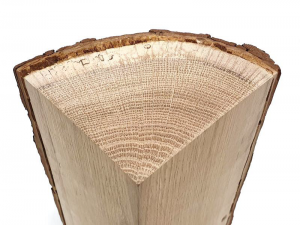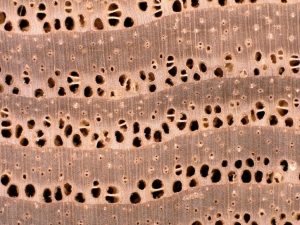
April 23, 2024


Tree development and growth is not so different than our own human development. Our fundamental requirements are the same in that we both need air, food, water and shelter to live. Beyond these general requirements, what makes us special is largely defined by where we grow up, what kind of environment we have around us, our fellow neighbors and our support system. Trees are no different, and they have very different behavior based on if they grow in the mountains, on a hillside, next to a river or in your garden. These aspects make us unique, define who we are and are part of us for our entire lives.
While in humans, many defining characteristics are held within our minds, in trees, we can physically see these differences. They present themselves in tree leaves, bark, size, seeds and wood. Even after a tree has died, we can look at the wood to understand that tree’s history and what makes it unique.
Wood is grown in trees to facilitate the movement of fluids and nutrients from the ground to the leaves to produce sugars via photosynthesis. Every year, more wood is produced that reflects the current state of the tree. As children, many of us counted the annual growth rings in logs to determine the age of a tree.

Figure 1. Annual growth rings help us to see the history of a tree’s growth. Photo: Matthew Schwarzkopf
These annual growth rings can also tell us much more about the tree than its age alone. For instance, they can also help us identify what was happening that year. Did a traumatic event occur, like a fire, lightning strike or infestation of insects? Did the ground shift and force the tree to adjust its growing direction? We can also use these annual growth rings to help identify what species the tree is. This identification helps us to understand how the tree’s wood can be used in our own lives for things like furniture, paper, toys or buildings.
The image below shows Fraxinus americana (Figure 2), commonly known as white ash. If you have ever used a wooden tool for digging a hole or for raking up leaves in your garden, it is very likely to have been made from ash. More notable is the use of white ash in baseball bats, hockey sticks and boat paddles. Both garden and sporting applications require the wood to absorb shock, rather than your hands. This property is defined by the internal structure of the wood. While a tree was never concerned with your ability to hit a home run, it was concerned with supporting its large crown and transporting water and sugar.

Figure 2. White ash is often used in handles for tools and baseball bats. Photo: Matthew Schwarzkopf
While freshly prepared wood like that in the white ash image above can be relatively easy to identify, what about wood found buried in the mud for hundreds or even thousands of years? Below is an image of a piece of wood that has been buried in mud for many years (Figure 3A). Archeologists in Serbia were curious about what types of tree species were used in the lives of the human beings at their dig site. This information could tell them more information about what types of trading occurred at that time in history.
While this type of wood is typically highly degraded, fragile and discolored, it is still possible to identify. Upon closer inspection, and slight changes in lighting, the unique features of the wood can be distinguished (Figure 3B). The first thing we can see are rows of large holes. These large holes transport fluids in the tree and grow in the springtime when there are more favorable growing conditions. These holes are characteristic of some hardwood trees, which helps eliminate all softwoods like pine, cedar and spruce from the possibilities.
What next? During the winter and slow growing times, the tree will produce a denser wood structure with smaller holes. Patterns and combinations of other features here can give us even more clues. Magnifying the image, we can see groups of smaller holes. These groups of smaller holes and flame-like patterns are often found in species of oak. Comparing with some current samples (Figure 3C), we can make an educated conclusion that the wood being used came from a common oak tree (Quercus robur).
By exploring these microscopic, anatomical features, we are able see the unique characteristics of tree species and identify them, even after hundreds of years. In addition to simply knowing what type of tree it was, the identification also helps us to understand what physical properties we can expect in order to safely design and build structures and items with the wood.
So, the next time you see a tree or piece of wood, remember that just like us, every tree is unique and has its own story. We are both a sum of our parts and special based on our upbringing and environment. More important than using these features as a forensic tool, these unique characteristics are what make life interesting and beautiful.
Dr Matthew Schwarzkopf,
researcher at Innorenew CoE